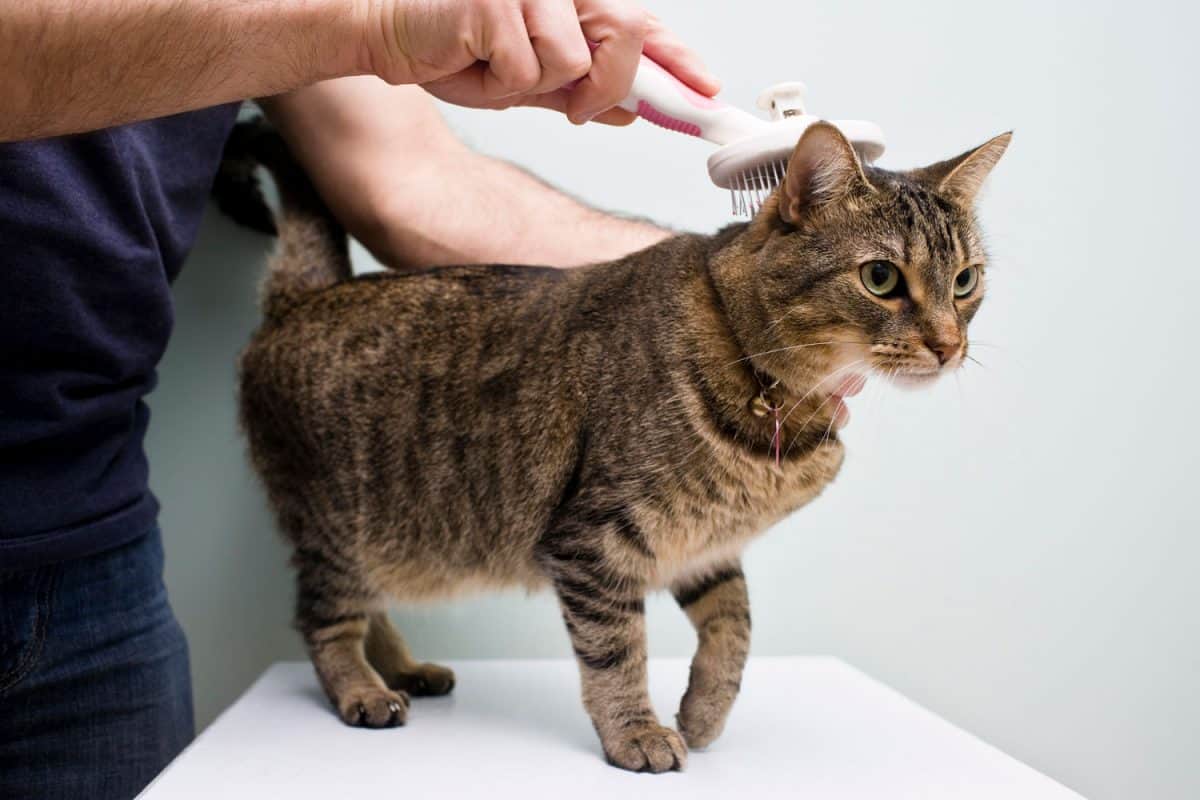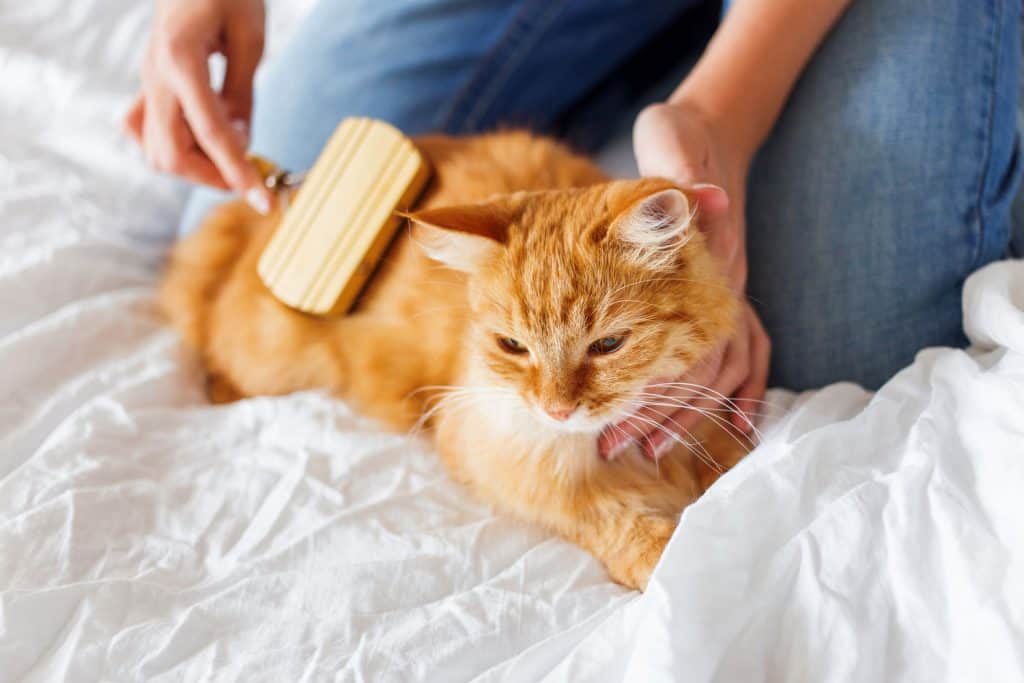Who doesn't enjoy the soothing activity of brushing their cat? But can too much of a good thing lead to problems, like your cat going bald? We have expert answers to the question, "Can you brush a cat too much?"
We will also explore the ins and outs of cat grooming. We'll look into how often you should brush your cat, what kind of brushes work best, and how brushing can reduce shedding. We'll also give some pointers on how to groom a cat that doesn't like being brushed.
You're about to become a pro at keeping your cat's coat glossy and healthy.
The Right Frequency For Brushing
Wondering when to pause the brush? Brushing is an essential part of your cat's grooming, but too much can lead to issues. Overbrushing can result in brush burn, skin irritations, or even bald patches on your pet's coat. This is why it's crucial to understand the right frequency for brushing your cat's hair.
Expert insights suggest that brushing your cat's hair 1 to 2 times a week is optimal to keep it healthy and tangle-free.
Why Brushing Benefits Your Cat's Health
But remember, brushing isn't merely about hair care. It goes deeper, benefiting your cat's skin health as well.
When brushing, you're not only styling their hair but also removing dead hair, dirt, and grease that has accumulated over time. This process helps extract unwanted skin flakes, stimulates blood circulation, and invigorates hair follicles, contributing to healthier skin and a shinier coat.
Before you begin brushing, take a moment to inspect your cat's body for any wounds or bumps. Be gentle and mindful while handling the brush, especially when dealing with mats or tangles. You want grooming to be a comfortable experience for your pet, not a painful one.
So, while brushing is integral to your pet's grooming, it's also essential to strike a balance to prevent damaging their coat. In the following sections, we'll share further tips and recommendations on the best ways to de-shed your cat without causing harm.

What Kind Of Brush Should I Use On My Cat?
While it is true that you should brush your cat's hair regularly, it is important to use the right brush so that you can do it effectively. Here are the most recommended brushes for specific types of cats:
Hertzko Self Cleaning Slicker Brush
This is recommended for cats with long hair and dense coats. It will be able to remove tangles and mats on their coats without hurting them.
Click here to find this product on Amazon.
Mars Boar Bristle Cat Hair Brush
This one should be used for cats with fine or short hair. It is a professional-grade grooming brush with very soft bristles that'll make your feline's coat shiny and healthy.
Check out this cat hair brush on Amazon.
Poodle Pet Detangling Comb
This is a good comb to use for any kind of cat's coat. It will help remove unwanted fur, tangles, and mats. It will also stimulate the hair follicles to enhance their growth.
Click this link to find this product on Amazon.
Will Brushing My Cat Reduce Shedding?
It is normal for cats to shed their hair. All cats go through this regularly no matter if they are short-haired or long-haired. They all shed their coats a little every day and felines usually undergo one or two shedding periods within a year. It is due to the changing of the seasons.
They have to lose some of their fur as summer approaches so that they can deal with the warmer weather much better.
Brushing your cat's hair will help a lot in reducing shedding. As you brush her hair, you'll be able to collect and get rid of all her excess hair before they fall on the ground or make their way all over your furniture.
So, if you're tired of having cat fur on your clothes all the time, make it a point to brush your pet's hair regularly.
However, some cats shed more hair due to having a poor diet, allergies, sunburn, or being stressed. It could also be caused by the medication that they're taking or because of an infection.
We recommend that you consult your vet when this happens so that you can be given the proper advice to reduce unwanted shedding.
What Is The Best Way To De-Shed A Cat?
If you're tired of having feline fur all over your clothes and furniture, you should de-shed your cat regularly. The best way to do it is by routinely brushing your feline's coat.
As mentioned earlier, this will help you collect your pet's hair even before they make it to the floor or your furniture or coat.
You should have the right de-shedding tool with you. It can be a comb or a brush or if your cat doesn't enjoy using them, you can go with a Furminator for cats, a coat spray, a shed control cloth, or a grooming mitt.
The important thing is that you get rid of all the loose hair of course without hurting your beloved pet. But if there's really excessive shedding, you have to bring your cat to your vet to address the issue.
You might need to change her diet and keep her hydrated all the time so that she'll have healthier skin and coat.
Can The Furminator Damage A Cat's Coat?
The Furminator is a pet grooming and non-abrasive de-shedding tool. Manufacturers say that using this tool will significantly reduce your cat's shedding and prevent tangles and mats.
It will also help reduce skin irritations and allergens. Furminator uses a unique kind of blade to remove your pet's loose hair and undercoat without doing any damage to her topcoat.
The stainless steel-edged blade has been carefully crafted so that it can precisely cut your cat's undercoat without hurting your pet.
Make sure you use the Furminator that's specifically designed for cats. It is also recommended for use only among felines that have an undercoat such as the American Bobtail, Bengal, California Spangled Cat, Himalayan, Persian, and Siamese cat breeds.
Before using this product, make sure you've understood the instructions. It is recommended to use the Furminator on your cat 1 to 2 times a week for about 15 minutes each time. But when your pet sheds heavily, then you can use it more frequently.
Check out this Furminator for small cats on Amazon.
How To Brush A Cat That Doesn't Want To Be Brushed
Some cats hate to be groomed and have their coats brushed. When you try to brush their fur, they may get aggressive. It could be because of a previous bad experience or they have matted hair that brushing hurts them so much.
But grooming is essential in keeping your pet healthy so here's what you can do so that brushing your feline's hair won't be such a stressful experience for both of you:
1. Change Their Attitude Towards Brushing
This doesn't happen overnight. You've got to be patient with your pet and let them develop a positive association with brushing their coat and grooming in general. The best way to do this is by positive reinforcement.
You can start off by putting the brush next to your cat and having her smell it. Give her a reward when she does this. When you see that she's starting to rub the bristles of the brush, reward her again with her favorite treat.
2. Take It Slow
Observe your cat and see if she's ready to let you brush her coat. Begin by gently combing her hair and seeing how she would react. Stop if she doesn't feel comfortable. Try again next time. Remember, you want your cat to associate brushing with a positive experience so don't rush or force her into it.
3. Find Out The Best Time To Brush Her Hair
You've got to determine when's the best time for you to brush your pet's coat. Do this when she's relaxing in her favorite spot. You can sit next to her and gently groom her coat. It is a great opportunity to bond with your pet.
But when you see that it's making her uncomfortable, stop and just try again some other time when she's calmer.
4. Use A Different Tool
If your pet has an aversion to brushes, there are other grooming tools that you can use as an alternative. You can try using a de-shedding tool, grooming mitts, a coat spray, or shed control cloths. These will help you to get rid of their unwanted hair effectively without actually combing their coat.
Here's another reminder: Don't ever let your cat play with her brush or grooming tool. You don't want her to think that it's a toy that she can play with. You want her to know that it's used for grooming so that she will behave appropriately when she sees it.

Final Thoughts: Can You Brush A Cat Too Much?
It is important to brush your cat's hair regularly not only to get rid of unwanted fur on your clothes and furniture.
Do it to keep her skin and coat healthy and tangle-free. But don't overdo it. Brushing her coat twice a week will do the trick and this is a great way to spend quality time with your pet.
You might also like:
Does Your Cat Shy Away From Grooming Others? Let’s Find Out Why!
4 Things Reddit Users Do to Groom Their Cats [And One They Don’t]

Some elements on this page may have been created by our team using advanced AI to provide you with top-notch cat inspired ideas. Read more about our AI Content Policy.




